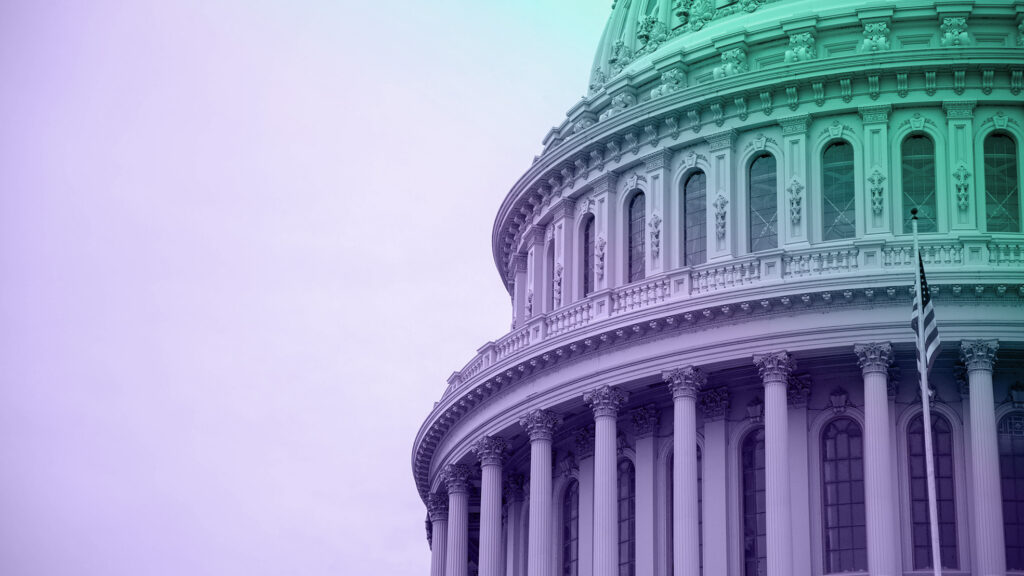Healthcare Legislation Has Bipartisan Support
January 31, 2022
Congress will likely pass significant bipartisan healthcare legislation in 2022, despite partisan divisions and the upcoming midterm elections. Congress will focus on broadly popular issues such as physician and hospital reimbursement, behavioral and mental health, and pharmaceutical and medical device development. This legislation will create opportunities for physicians and hospitals, home health agencies, diagnostic and device manufacturers, telehealth platforms, and behavioral health companies, but lead to risks for pharmacy benefit managers and skilled nursing facilities.
Despite intense partisan divisions and the midterm elections, Congress is likely to pass improvements to several policy areas that have bipartisan support. The lame duck session of 2022 provides an opportunity for bipartisan legislating following the elections.
Notably, consideration of topics like telehealth and pharmaceutical development combined with a viable legislative vehicle will likely invite efforts by organized interests and lawmakers to address other concerns, including Medicare payments and sequester and pharmacy benefit managers (PBMs). Passage will likely be combined with and anchored by either the Cures 2.0 Act or a second version of the Substance Use Disorder Prevention that Promotes Opioid Recovery and Treatment for Patients and Communities (SUPPORT) Act.
Opportunities in 2022
A large legislative vehicle will benefit behavioral and mental health providers as well as pharmaceutical R&D
- Winners: Behavioral and Mental Health: Acadia Healthcare (ACHC), Universal Health Services (UHS), Indivior (INDV on the London exchange)
Drug overdose deaths in the US topped 100,000 in the 12 months ending April 2021, the largest number of recorded deaths since the Department of Health and Human Services (HHS) declared the opioid epidemic a public health emergency in 2017. In 2018, Congress passed the SUPPORT Act, which made several policy changes, largely to Medicaid, to improve access to individuals suffering from substance use disorder (SUD).
Capstone expects a similar push from Congress in 2022 driven by the Bipartisan Addiction and Mental Health Task Force. The task force consists of 144 members of Congress and recently introduced 66 bills focused on mental and behavioral health.
The staggering number of overdose deaths combined with a strong bipartisan coalition likely means the issue will remain front and center for lawmakers this year and could form the basis for a broader bipartisan healthcare legislative package.
Such legislation is likely to benefit behavioral and mental health firms such as Acadia (ACHC), Universal Health Services (UHS), Indivior (INDV on the London exchange).
Moreover, in 2022, Reps. Diana DeGette (D-CO) and Fred Upton (R-MI) intend to build on the success of the 21st Century Cures Act, which they spearheaded in 2016. In November 2021, the lawmakers released text of the Cures 2.0 Act. The bill would fund the new Advanced Research Projects Agency for Health (ARPA-H), expand telehealth coverage akin to the Telehealth Modernization Act, and require Medicare to cover Food and Drug Administration-approved breakthrough products and devices for four years.
Like the second rendition of the SUPPORT Act, we believe Cures 2.0 could form the basis for a broader bipartisan healthcare legislative package. Cures 2.0 is likely to benefit firms engaged in pharmaceutical research and development, medical device manufacturers, and telehealth platforms.
Lawmakers will likely pass healthcare priorities by attaching provisions to a popular bill.
A large bipartisan healthcare package presents an open vehicle for other healthcare policy riders.
Winners:
- Home Health: Amedisys (AMED), LHC Group (LHCG), Addus Homecare (ADUS), Option Care Health (OPCH)
- Providers and Staffing Firms: HCA Healthcare (HCA), Tenet Healthcare (THC), Envision Healthcare (EVHC), TeamHealth (TMH), Labcorp (LH), Quest Diagnostics (DGX)
- Telehealth: Teladoc Health (TDOC), Amwell (AMWL)
- Medical Device: Medtronic (MDT), Boston Scientific (BSX), Stryker (SYK)
Beyond behavioral and mental health providers, directly addressed in a potential SUPPORT 2.0, lawmakers and organized interests will likely pass healthcare priorities by attaching provisions to a popular bill.
Provider Reimbursement: Congress acted yet again in 2021 to stabilize Medicare physician payments, providing a 3.0% boost to the physician fee schedule (PFS) for 2022 (down from 3.75% in 2021), extend the 2% Medicare sequester moratorium for one quarter (and provide 1% sequester relief for a second quarter), and delay the Protecting Access to Medicare Act (PAMA) laboratory reporting requirements and payment cuts for another year. Providers, including hospitals and physicians, along with laboratories will likely try to include a permanent fix to these annual reimbursement issues in a broader healthcare bill.
Alternatively, Congress could choose to address provider reimbursement through standalone legislation or as a rider to a must-pass bill such as a government funding bill (February 18, 2022), reauthorization of the Prescription Drug User Fee Act (September 2022), the FY2023 National Defense Authorization Act (end of 2022), or a bill to raise the debt limit (early 2023).
We expect the hospital and provider lobbies to push hard for a full year moratorium of the 2% Medicare sequester as part of the government funding bill in February, as the 2% relief is scheduled to be reduced to 1% relief after March 31, 2022, and completely phase out after June 30, 2022. PFS relief and a delay to PAMA cuts are scheduled to roll off at the end of the year, giving the specialty physician and laboratory lobbies more time to attach 2023 relief to a bill in 2022.
Telehealth: Capstone views telehealth as one of the several bipartisan healthcare issues likely to gain traction in 2022, particularly because telehealth has played such a crucial role during the pandemic. The Telehealth Modernization Act, found in Cures 2.0 and supported by the American Telehealth Association (ATA), would eliminate originating site requirements so beneficiaries are able to furnish telehealth services in any location. During the pandemic, the Medicare program and many Medicaid programs waived originating site requirements. However these policies are currently temporary and will expire at the end of the PHE. Making these flexibilities permanent is the number one priority for industry, which views the site requirements as the foremost barrier to telehealth uptake and a larger barrier to access than payment parity.
Medical Devices: If passed, the four-year coverage provision found in the Cures 2.0 Act would be especially beneficial to medical device manufacturers, since the Biden administration recently repealed the Trump administration’s Medicare Coverage of Innovative Technology (MCIT) rule. The repealed rule would have granted similar Medicare coverage for four years to breakthrough products and devices.
Home Care: If the ultimate Build Back Better legislation fails to include funding for home- and community-based services (HCBS), or includes it at a significantly reduced level, Capstone believes there is an appetite in Congress to pass home care reforms. The pandemic- and resulting vaccine mandates- have exacerbated staffing shortages and highlighted the need for changes to the home care delivery system. In addition to increased funding for state Medicaid programs, Congress may look to pass two underappreciated bipartisan home care bills, the Choose Home Care Act of 2021 and the Preserving Patient Access to Home Infusion Act. The Choose Home Care Act would create a new add-on payment for the traditional 30-day home care episode in Medicare while the Preserving Patient Access to Home Infusion Act would increase reimbursement rates for existing Medicare home infusion patients.
Risks in 2022
Pharmacy benefit managers will see additional scrutiny.
- Losers: PBMs such as OptumRx (UNH), CVS Caremark (CVS), Express Scripts (CI)
For several years, lawmakers, regulators, and states have scrutinized pharmacy benefit managers (PBMs) as manufacturer rebates continue to climb and pharmacy direct and indirect remuneration (DIR) fees have ballooned, increasing by 107,400% between 2010 and 2020. Addressing PBMs has bipartisan support on the Hill. However, curtailing PBMs’ use of rebates would likely cause premiums to rise, which has kept legislation at bay. We believe a bipartisan healthcare package may finally be the vehicle—and the moment—to attach legislation. Moreover, the Centers for Medicare & Medicaid Services’ (CMS) recent proposed rule addressing DIR fees with the associated premium increase and government cost give lawmakers more room to take additional action on PBMs given that $40 billion in costs and a 5% premium increase will have already be borne by CMS and not.
The most likely policy changes start with transparency initiatives, moving to a ban on spread pricing in Medicaid to generate savings, restrictions on copay adjusters, and finally restrictions on pharmacy DIR fees and “clawbacks” beyond what the CMS rule proposes.
Regardless of what Congress does, ongoing pharmacy closures combined with states’ ability to craft PBM legislation in a post Rutledge v. Pharmaceutical Care Management Association world will likely cause even more legislation at the state level in 2022 and beyond. States have and will likely continue to carve out the pharmaceutical benefit from managed Medicaid contracts, ban co-pay adjustment tools such as maximizers and accumulators, prohibit pharmacy “clawbacks,” mandate transparency, and regulate white bagging, among other policies. State action on these novel policies could inform federal legislation in the future.
Institutional long-term care providers cede market share to home care.
- Losers: Skilled nursing facilities such as Ensign Group (ENSG), Omega Healthcare (OHI)
Increasing and expanded reimbursement for home care combined with efforts to shrink the home care waitlists threaten to further reduce skilled nursing facility (SNF) occupancy. Occupancy at SNFs is still well below pre-pandemic levels (76.3% in 3Q 2021 vs. 86.6% pre-pandemic), though it has improved since mid to late 2020. We believe skilled nursing will still be valuable for years to come as the home setting is still not appropriate for high acuity patients. However, SNFs rely on Medicare revenue—with far higher reimbursement than Medicaid—for financial stability. Any effort to shift patients away from Medicare into Medicaid, reduce Medicare volumes, or lower Medicare reimbursement would present significant headwinds to SNFs beyond the broader shift to the home setting from the institutional setting.
ABOUT THE AUTHOR
Hunter Hammond is a vice president on Capstone’s healthcare team.



























